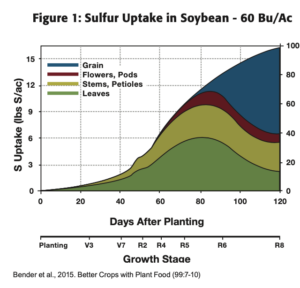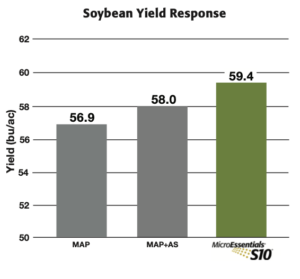OVERVIEW
- Monoammonium phosphate (MAP) is a common phosphorus source used in soybean production.
- New university research highlights the need for sulfur (S) management in soybean due to higher grain yields and lower atmospheric deposition. Data also emphasize the need for S during both vegetative and reproductive growth (see Figure 1).
- MicroEssentials S10 supplies multiple nutrients fused into one nutritionally balanced granule, promoting uniform nutrient distribution, increased nutrient uptake, season-long S availability and higher yields.

TRIAL DETAILS
Crop: Soybean (Glycine max)
Years: 2018-2020
Locations: 21 trials – AR, IL, MI, OH, ON, TN, WI
Data Source: Field studies conducted by independent, third-party researchers.
Experimental Design: Small-plot RCBD with 4 replications.
Cropping Conditions: All trials conformed to local cropping practices.
TREATMENTS:
Treatment (Trmnt) / Rates / Timing:
- P Rate: 40 lbs P₂O₅/ac applied as MAP or MicroEssentials S10
- K Rate: 60 lbs K₂O/ac applied accross all treatments
- S Rate: 10 lbs S/ac applied as AS or MicroEssentials S10
- Application Timing: Spring Preplant
Application Method: Broadcast Incorporated
RESULTS

SUMMARY
- Soybean yield increased with the addition of S.
- Averaged across 21 site-years, MicroEssentials S10 increased soybean yield 2.5 bu/ac over MAP and 1.4 bu/ac over MAP + AS.
- MicroEssentials S10 demonstrates the value of uniform nutrient distribution, increased nutrient uptake, and two forms of S (sulfate and elemental) for season-long S availability.